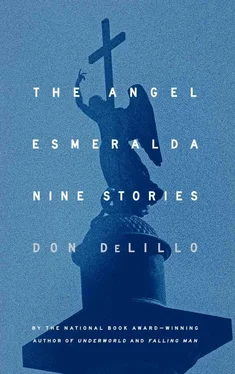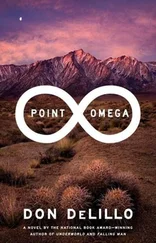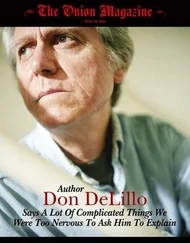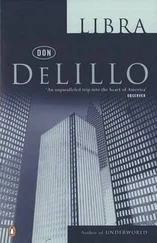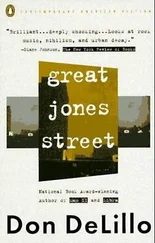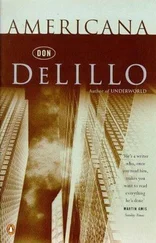Sister Jan said, “I don’t know.”
“Of course you know. You know. You saw her.”
“I don’t know. It was a shadow.”
“Esmeralda on the lake.”
“I don’t know what I saw.”
“You know. Of course you know. You saw her.”
They waited for two more trains. Landing lights appeared in the sky and the planes kept dropping toward the runway across the water, another flight every half minute, the backwashed roars overlapping so everything was seamless noise and the air had a stink of smoky fuel. They waited for one more train.
How do things end, finally, things such as this — peter out to some forgotten core of weary faithful huddled in the rain?
The next night a thousand people filled the area. They parked their cars on the boulevard and tried to butt and pry their way onto the traffic island but most of them had to stand in the slow lane of the expressway, skittish and watchful. A woman was struck by a motorcycle, sent swirling into the asphalt. A boy was dragged a hundred yards, it is always a hundred yards, by a car that kept on going. Vendors moved along the lines of stalled traffic, selling flowers, soft drinks and live kittens. They sold laminated images of Esmeralda printed on prayer cards. They sold pinwheels that never stopped spinning.
The night after that the mother showed up, Esmeralda’s lost mother, and she collapsed with flung arms when the girl’s face appeared on the billboard. They took her away in an ambulance that was followed by a number of TV trucks. Two men fought with tire irons, blocking traffic on a ramp. Helicopter cameras filmed the scene and the police trailed orange caution tape through the area — the very orange of the living juice.
The next night the sign was blank. What a hole it made in space. People came and did not know what to say or think, where to look or what to believe. The sign was a white sheet with two microscopic words, space available, followed by a phone number in tasteful type.
When the first train came, at dusk, the lights showed nothing.
And what do you remember, finally, when everyone has gone home and the streets are empty of devotion and hope, swept by river wind? Is the memory thin and bitter and does it shame you with its fundamental untruth — all nuance and wishful silhouette? Or does the power of transcendence linger, the sense of an event that violates natural forces, something holy that throbs on the hot horizon, the vision you crave because you need a sign to stand against your doubt?
Edgar held the image in her heart, the grained face on the lighted board, her virgin twin who was also her daughter. She recalled the smell of jet fuel. This became the incense of her experience, the burnt cedar and gum, a retaining medium that kept the moment whole, all the moments, the stunned raptures and swells of fellow feeling.
She felt the pain in her joints, the old body raw with routine pain, pain at the points of articulation, prods of sharp sensation in the links between bones.
She rose and prayed.
Pour forth we beseech Thee, O Lord, Thy grace into our hearts.
Ten years if recited at dawn, noon and eventide, or as soon thereafter as possible.
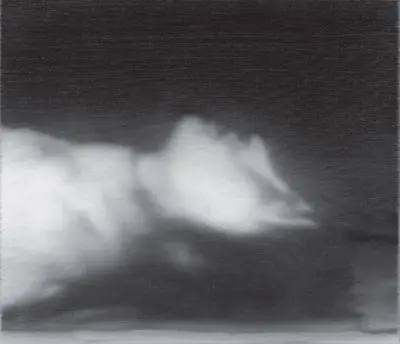
She knew there was someone else in the room. There was no outright noise, just an intimation behind her, a faint displacement of air. She’d been alone for a time, seated on a bench in the middle of the gallery with the paintings set around her, a cycle of fifteen canvases, and this is how it felt to her, that she was sitting as a person does in a mortuary chapel, keeping watch over the body of a relative or a friend.
This was sometimes called the viewing, she believed.
She was looking at Ulrike now, head and upper body, her neck rope-scorched, although she didn’t know for certain what kind of implement had been used in the hanging.
She heard the other person walk toward the bench, a man’s heavy shuffling stride, and she got up and went to stand before the picture of Ulrike, one of three related images, Ulrike dead in each, lying on the floor of her cell, head in profile. The canvases varied in size. The woman’s reality, the head, the neck, the rope burn, the hair, the facial features, were painted, picture to picture, in nuances of obscurity and pall, a detail clearer here than there, the slurred mouth in one painting appearing nearly natural elsewhere, all of it unsystematic.
“Why do you think he did it this way?”
She did not turn to look at him.
“So shadowy. No color.”
She said, “I don’t know,” and went to the next set of images, called Man Shot Down . This was Andreas Baader. She thought of him by his full name or surname. She thought of Meinhof, she saw Meinhof as first name only, Ulrike, and the same was the case with Gudrun.
“I’m trying to think what happened to them.”
“They committed suicide. Or the state killed them.”
He said, “The state.” Then he said it again, deep-voiced, in a tone of melodramatic menace, trying out a line reading that might be more suitable.
She wanted to be annoyed but felt instead a vague chagrin. It wasn’t like her to use this term— the state —in the ironclad context of supreme public power. This was not her vocabulary.
The two paintings of Baader dead in his cell were the same size but addressed the subject somewhat differently, and this is what she did now — she concentrated on the differences, arm, shirt, unknown object at the edge of the frame, the disparity or uncertainty.
“I don’t know what happened,” she said. “I’m only telling you what people believe. It was twenty-five years ago. I don’t know what it was like then, in Germany, with bombings and kidnappings.”
“They made an agreement, don’t you think?”
“Some people believe they were murdered in their cells.”
“A pact. They were terrorists, weren’t they? When they’re not killing other people, they’re killing themselves,” he said.
She was looking at Andreas Baader, first one painting, then the other, then back again.
“I don’t know. Maybe that’s even worse in a way. It’s so much sadder. There’s so much sadness in these pictures.”
“There’s one that’s smiling,” he said.
This was Gudrun, in Confrontation 2.
“I don’t know if that’s a smile. It could be a smile.”
“It’s the clearest image in the room. Maybe the whole museum. She’s smiling,” he said.
She turned to look at Gudrun across the gallery and saw the man on the bench, half turned her way, wearing a suit with tie unknotted, going prematurely bald. She only glimpsed him. He was looking at her but she was looking past him to the figure of Gudrun in a prison smock, standing against a wall and smiling, most likely, yes, in the middle picture. Three paintings of Gudrun, maybe smiling, smiling and probably not smiling.
“You need special training to look at these pictures. I can’t tell the people apart.”
“Yes, you can. Just look. You have to look.”
She heard a note of slight reprimand in her voice. She went to the far wall to look at the painting of one of the jail cells, with tall bookshelves covering nearly half the canvas and a dark shape, wraithlike, that may have been a coat on a hanger.
“You’re a grad student. Or you teach art,” he said. “I’m frankly here to pass the time. That’s what I do between job interviews.”
She didn’t want to tell him that she’d been here three straight days. She moved to the adjacent wall, a little closer to his position on the bench. Then she told him.
Читать дальше
